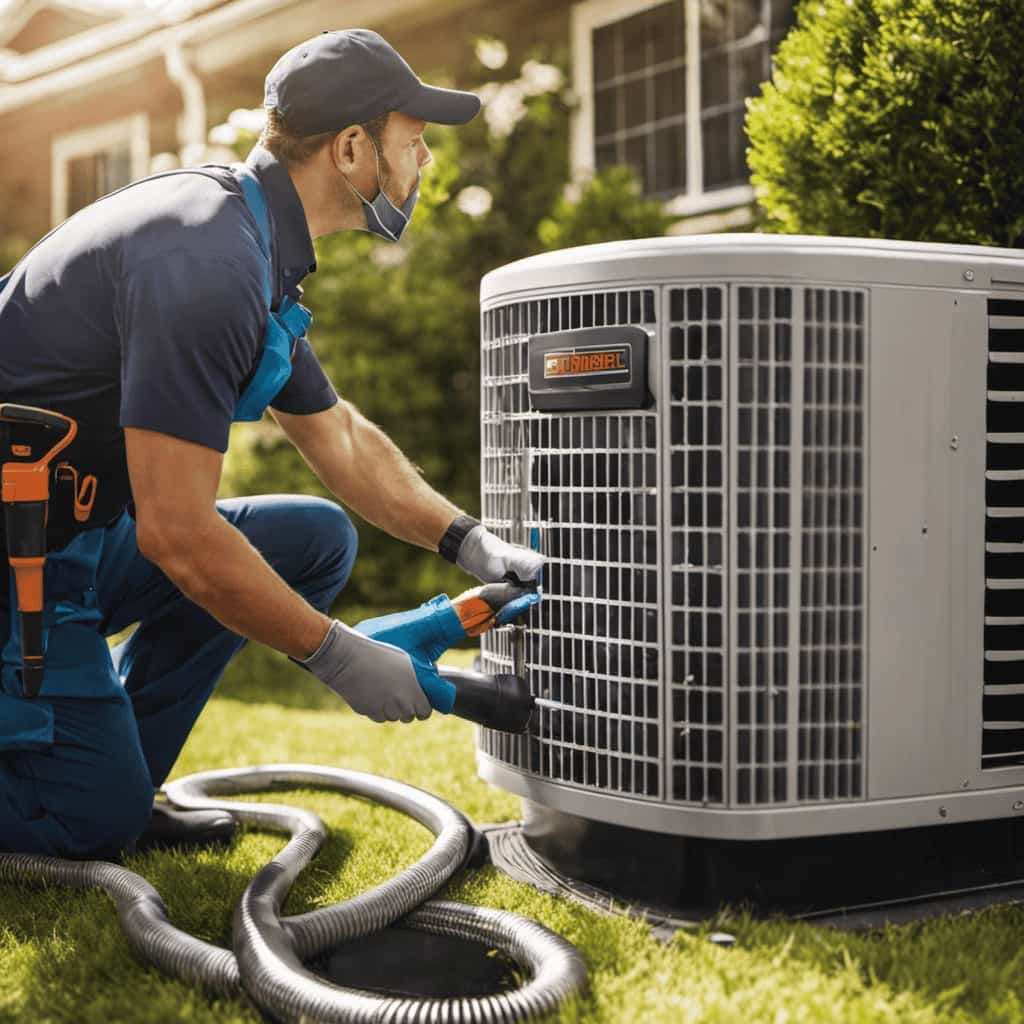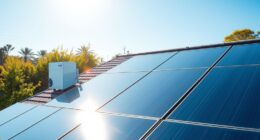Want to optimize your heat pump’s performance? You’re in the right place! This article will guide you through six essential steps to enhance your heat pump efficiency.
From understanding ratings to optimizing thermostat settings, we’ve got you covered.
Regular maintenance and cleaning, proper insulation and airflow, and utilizing smart technology are all essential.
Plus, we’ll even discuss supplementary heating options.

Get ready to save energy and serve your home with these expert tips!
Key Takeaways
- Regular maintenance and cleaning are essential for maximizing heat pump efficiency.
- Professional servicing helps identify potential problems before they become major issues.
- Optimizing thermostat settings can greatly improve energy efficiency.
- Supplementary heating options can enhance comfort and energy efficiency.
Understanding Heat Pump Efficiency Ratings
Now let’s delve into the details and understand the key factors that contribute to heat pump efficiency ratings.
Heat pump efficiency ratings are essential because they determine how effectively your heat pump can heat or cool your home while minimizing energy consumption. The higher the efficiency rating, the more energy-efficient your system is, resulting in significant cost savings and reduced environmental impact.
One of the main benefits of a high-efficiency heat pump is its ability to provide consistent heating or cooling without consuming excessive energy.

To maximize the efficiency of your heat pump, here are some essential tips:
-
Regularly clean and maintain your heat pump to ensure optimal performance.
-
Use a programmable thermostat to control temperature settings and reduce energy usage.
-
Properly insulate your home to minimize heat loss and improve overall efficiency.

Regular Maintenance and Cleaning
When it comes to maximizing the efficiency of your heat pump, regular maintenance and cleaning are essential. By scheduling professional servicing at least once a year, you can ensure that any potential issues are addressed promptly and that your heat pump is operating at its optimal performance.
Additionally, cleaning the condenser coils on a regular basis helps to remove dirt, debris, and other contaminants that can hinder the heat transfer process and reduce the overall efficiency of your heat pump.
Importance of Professional Servicing
We highly recommend scheduling regular maintenance and cleaning for your heat pump to ensure optimal efficiency. Professional servicing is essential for maintaining the performance and longevity of your heat pump.
Here are some reasons why you should consider professional expertise for your heat pump:

- Expert Knowledge: HVAC professionals have the knowledge and experience to accurately diagnose and address any issues with your heat pump.
- Preventive Maintenance: Regular servicing helps identify potential problems before they become major issues, saving you from costly repairs down the line.
- Increased Efficiency: Clean and well-maintained heat pumps operate more efficiently, reducing energy consumption and lowering your utility bills.
- Cost-Effective Solutions: Professionals can offer cost-effective solutions for improving the efficiency of your heat pump, such as upgrading outdated components or optimizing system settings.
Cleaning Condenser Coils Regularly
Regularly cleaning and maintaining the condenser coils is essential for maximizing the efficiency of your heat pump. Over time, these coils can become dirty and clogged with dirt, dust, and debris, which can hinder the heat transfer process. To ensure optimal performance, it’s important to regularly clean the condenser coils using proper cleaning techniques.
Start by turning off the power to the heat pump and removing any debris or obstructions from the surrounding area. Gently brush away any loose dirt or debris from the coils using a soft brush or vacuum cleaner. For stubborn dirt and grime, a mixture of mild detergent and water can be used to clean the coils. Be sure to rinse the coils thoroughly and allow them to dry completely before turning the power back on.
Optimizing Thermostat Settings
When it comes to optimizing thermostat settings for heat pump efficiency, there are a few key points to consider.
First, it’s important to understand the ideal temperature ranges for both heating and cooling modes to ensure optimal comfort and energy savings.

Additionally, utilizing a smart thermostat can provide benefits such as remote access and learning capabilities to further enhance efficiency.
Lastly, taking advantage of energy-saving scheduling options, such as setting lower temperatures during periods of absence, can significantly reduce energy consumption.
Ideal Temperature Ranges
Our recommended temperature range for optimizing thermostat settings is between 68 and 72 degrees Fahrenheit. Maintaining the right temperature in your home is crucial for efficient temperature control and reducing energy consumption.
Here are some key reasons why this temperature range is ideal:

-
Energy Efficiency: By setting your thermostat within this range, you can ensure that your heat pump operates at its most efficient level, saving you energy and reducing your utility bills.
-
Comfort: This temperature range provides a comfortable indoor environment for most people, allowing you to enjoy a cozy and relaxing atmosphere in your home.
-
Health Benefits: Maintaining a consistent temperature within this range can help promote better sleep, reduce allergies, and prevent dryness or humidity-related issues.
-
Environmental Impact: By optimizing your thermostat settings, you can contribute to reducing greenhouse gas emissions and minimizing your carbon footprint.

Transitioning to the subsequent section about ‘smart thermostat benefits’, let’s explore how these innovative devices can further enhance temperature control and energy efficiency.
Smart Thermostat Benefits
Let’s explore how smart thermostats can optimize thermostat settings and enhance energy efficiency. Smart thermostats offer a range of features that enable precise control over your heating and cooling system, resulting in reduced energy consumption and increased cost savings. By utilizing advanced technology and automation, these devices can intelligently adjust temperature settings based on your preferences and occupancy patterns. With the ability to create customized schedules and remotely control your thermostat, you can ensure that your home is always at the ideal temperature when you need it. Additionally, smart thermostats provide valuable insights into your energy usage, allowing you to identify areas for improvement and make informed decisions to further reduce energy consumption. Take a look at the table below to see some key features of smart thermostats that contribute to energy efficiency.
| Feature | Description |
|---|---|
| Programmable Schedules | Set temperature settings for different times of the day to optimize energy usage. |
| Occupancy Sensors | Automatically adjust temperature based on whether the room is occupied or vacant. |
| Learning Capabilities | Adapt to your preferences and habits over time, creating personalized temperature settings. |
| Remote Access | Control your thermostat from anywhere using a smartphone or computer, allowing for efficient temperature management. |
Energy-Saving Scheduling Options
To optimize thermostat settings and maximize energy efficiency, we can explore energy-saving scheduling options. By utilizing a smart home system or a programmable thermostat, you can take advantage of the following energy-saving features:
- Customized schedules: Create personalized heating and cooling schedules based on your daily routines and preferences.
- Geofencing: Set your thermostat to adjust automatically when you leave or return home, ensuring comfort while saving energy.
- Temperature setbacks: Program your thermostat to lower the temperature when you’re asleep or away, reducing energy consumption.
- Remote access: Control your thermostat settings from anywhere using your smartphone or computer, allowing you to make adjustments on the go.
These energy-saving scheduling options not only enhance your comfort but also help reduce energy usage and lower utility bills. With the convenience and efficiency of smart home technology and programmable thermostats, you can effortlessly optimize your heat pump’s performance while saving energy.

Ensuring Proper Insulation and Airflow
Improving insulation and optimizing airflow are crucial steps in maximizing the efficiency of our heat pump. Proper insulation ensures that the heat generated by the pump stays inside, preventing any loss and reducing the workload on the system. On the other hand, improved ventilation and airflow help in dissipating any excess heat, preventing overheating and maintaining the pump’s performance. To help you understand the importance of insulation and airflow, take a look at the table below:
| Issue | Impact | Solution |
|---|---|---|
| Poor insulation | Heat loss, decreased efficiency | Properly insulate walls, floors, and ceilings |
| Inadequate airflow | Overheating, reduced performance | Clear obstructions, maintain vents and ducts |
Utilizing Smart Technology for Energy Management
How can we utilize smart technology to enhance the energy management of our heat pump?
Smart home automation systems offer various features that can help optimize the energy efficiency of your heat pump. Here are some ways you can leverage smart technology for energy management:
-
Remote temperature control: With smart thermostats, you can easily adjust the temperature settings of your heat pump from anywhere using your smartphone or voice commands.

-
Energy usage monitoring: Smart systems allow you to monitor your heat pump’s energy consumption in real-time, helping you identify energy-saving opportunities and make informed decisions.
-
Scheduling and automation: Set customized schedules for your heat pump to ensure it operates efficiently when needed and reduces energy consumption during off-peak hours.
-
Integration with other smart devices: Smart home automation platforms enable seamless integration with other devices, such as occupancy sensors and weather forecasts, to optimize your heat pump’s performance.
Considering Supplementary Heating Options
We can explore additional heating options to enhance the efficiency of our heat pump. While heat pumps are a great source of heating, there may be times when they struggle to keep up with extreme temperatures. In such cases, incorporating supplementary heating alternatives can help ensure optimal comfort and energy efficiency. Here are some cost-effective solutions to consider:

| Supplementary Heating Alternatives | Description | Benefits |
|---|---|---|
| Electric Space Heaters | Portable heaters that can be used to heat specific areas of the house. | Energy-efficient and can be easily moved around. |
| Biomass Stoves | Stoves that burn organic materials like wood pellets or agricultural waste to produce heat. | Renewable fuel source and can reduce heating costs. |
| Ductless Mini-Split Systems | Systems consisting of an outdoor compressor unit and indoor air handler units. | Provide targeted heating to specific rooms and have high energy efficiency. |
Frequently Asked Questions
Are There Any Government Incentives or Rebates Available for Upgrading to a More Efficient Heat Pump?
Yes, there are government incentives and rebates available for upgrading to a more efficient heat pump. These incentives aim to encourage energy savings and can provide financial assistance for the purchase and installation of a new heat pump.
How Often Should I Schedule Professional Maintenance for My Heat Pump?
We find that scheduling professional maintenance for our heat pump on a regular basis is crucial. The frequency of scheduling depends on factors such as climate and usage. The benefits of professional maintenance include improved efficiency and extended lifespan.
Can I Install a Heat Pump Myself, or Should I Hire a Professional?
We highly recommend hiring a professional for heat pump installation. While DIY installation may seem tempting, it can be complex and requires expertise. A professional ensures proper installation, maximizing efficiency and avoiding potential issues.
What Are the Most Common Signs That My Heat Pump May Need Repairs?
Common signs of heat pump repairs include strange noises, reduced heating or cooling output, frequent cycling on and off, and higher energy bills. Troubleshooting these issues can help identify the problem and determine if professional repairs are needed.

Is It Possible to Use My Heat Pump for Both Heating and Cooling Purposes?
Yes, it is possible to use your heat pump for both heating and cooling purposes. Heat pump compatibility allows for the dual functionality of heat pumps, providing efficient and versatile climate control for your home.
Conclusion
In conclusion, by following these six key steps, you can significantly boost the efficiency of your heat pump.
Understanding and optimizing its efficiency ratings, regular maintenance and cleaning, optimizing thermostat settings, ensuring proper insulation and airflow, utilizing smart technology, and considering supplementary heating options are all essential for achieving maximum energy savings.
So, start implementing these strategies today to enjoy a more efficient and cost-effective heating system.

Stay smart, save energy, and supercharge your heat pump efficiency!









